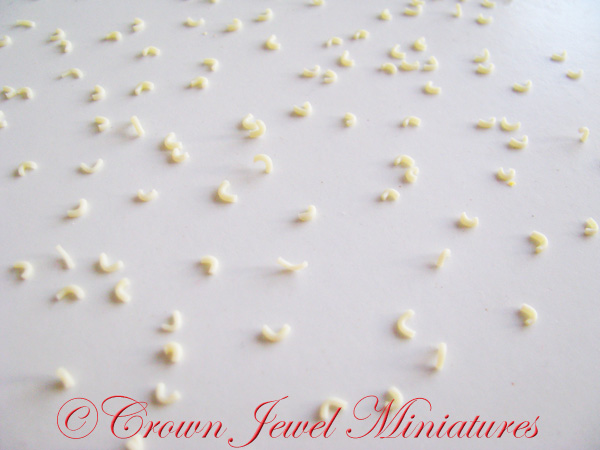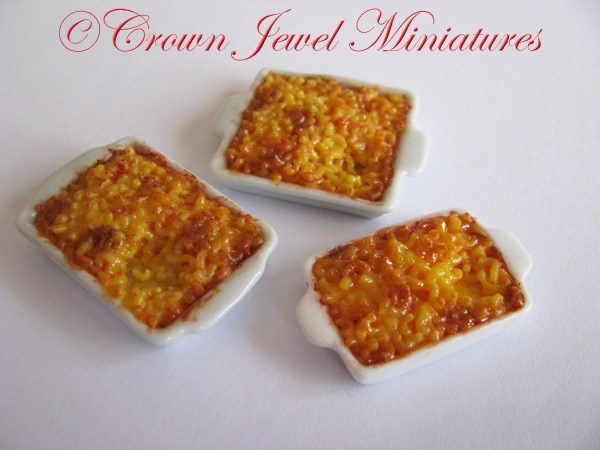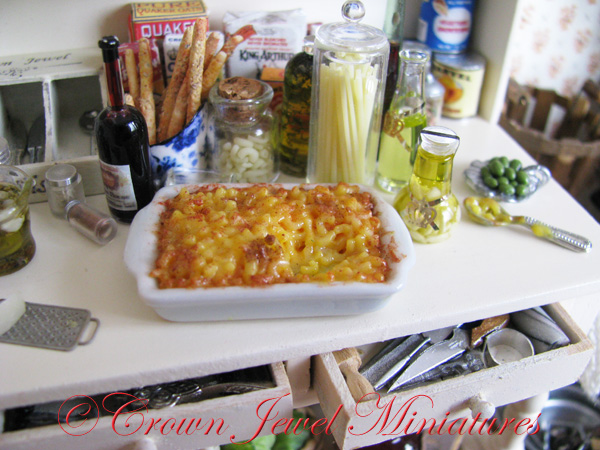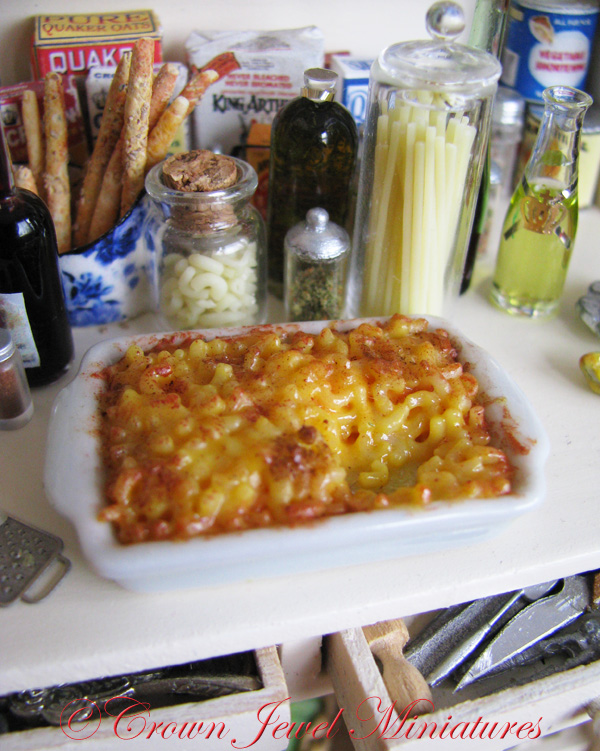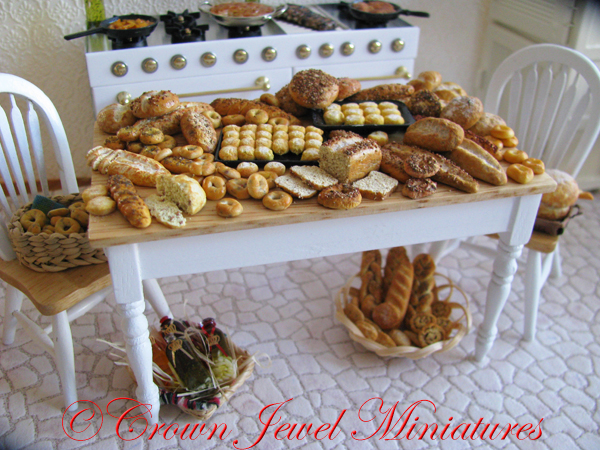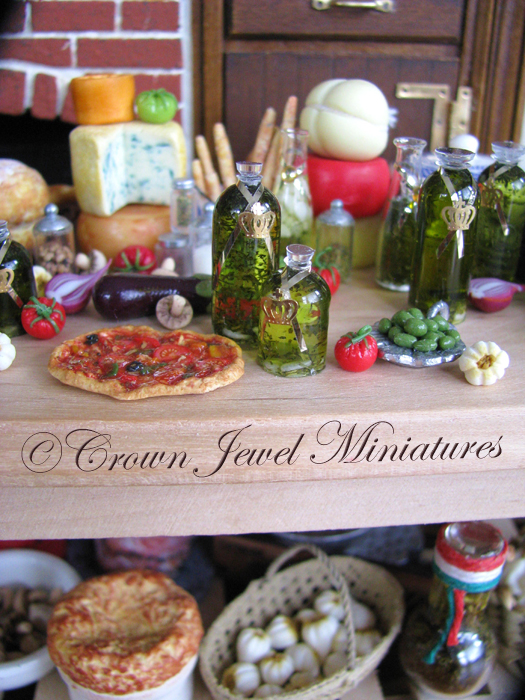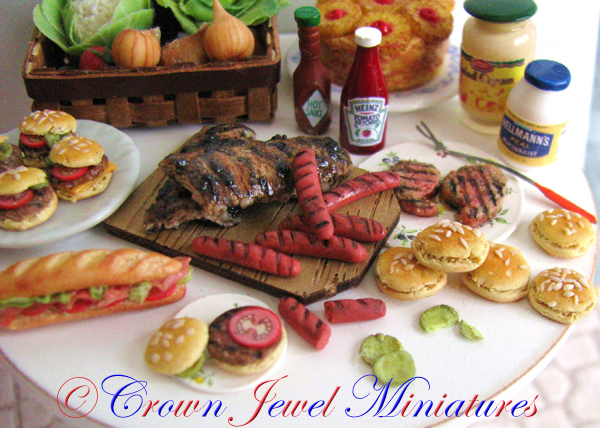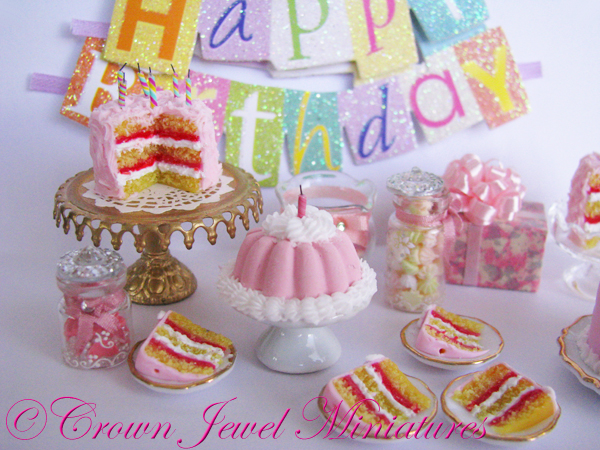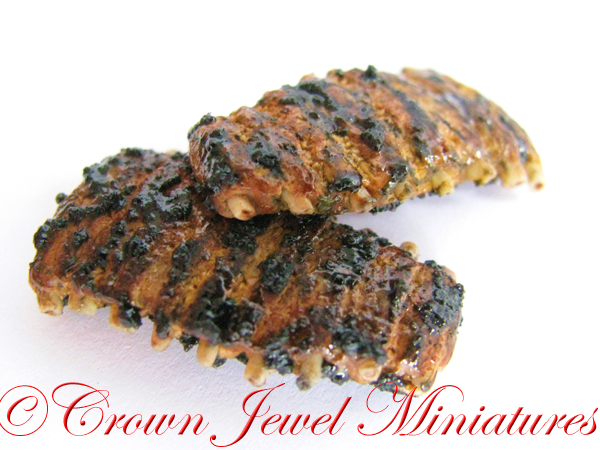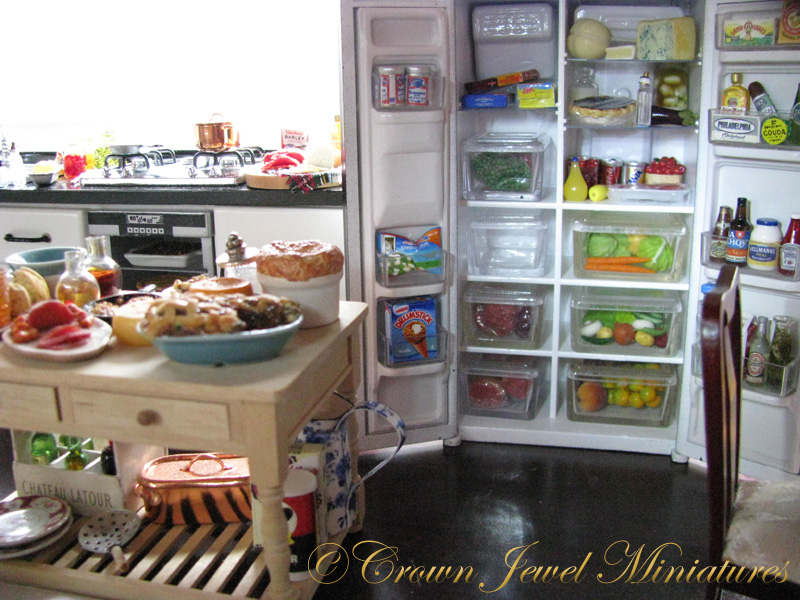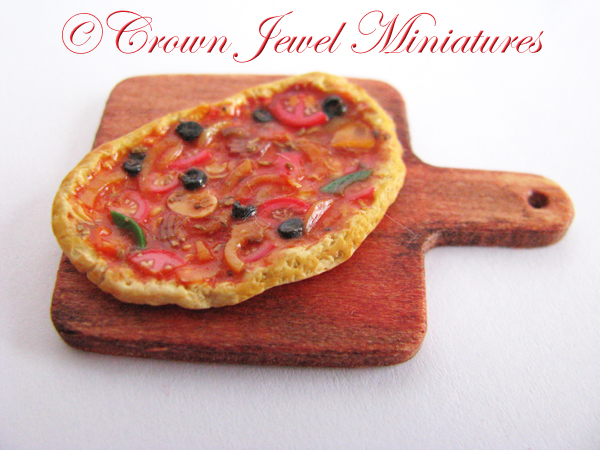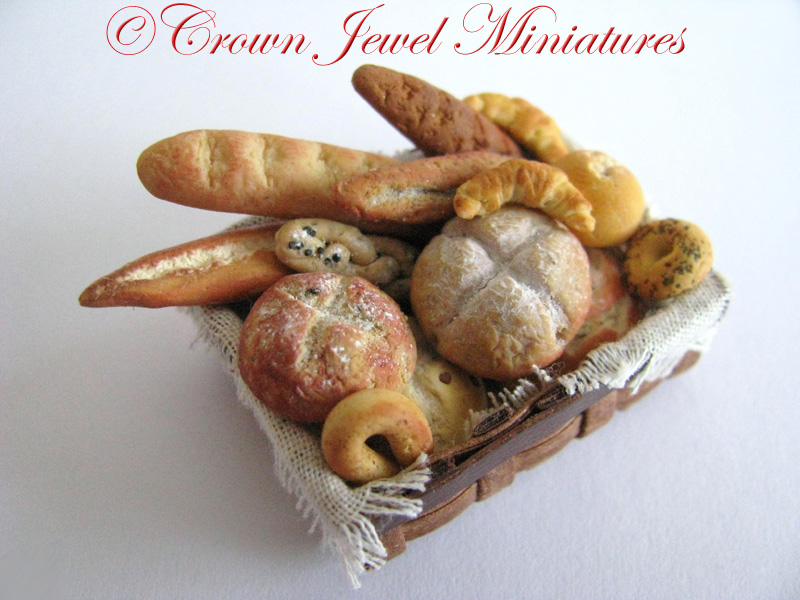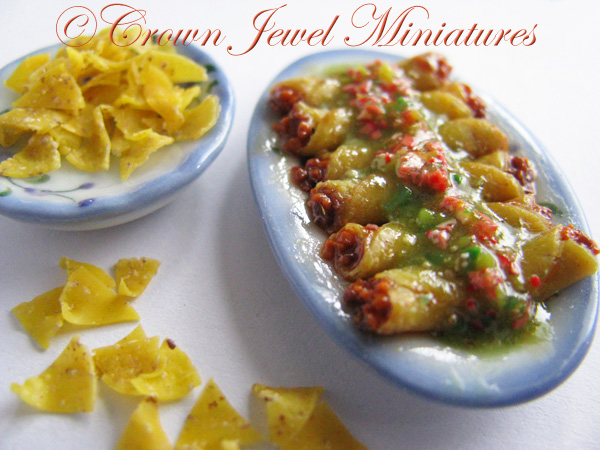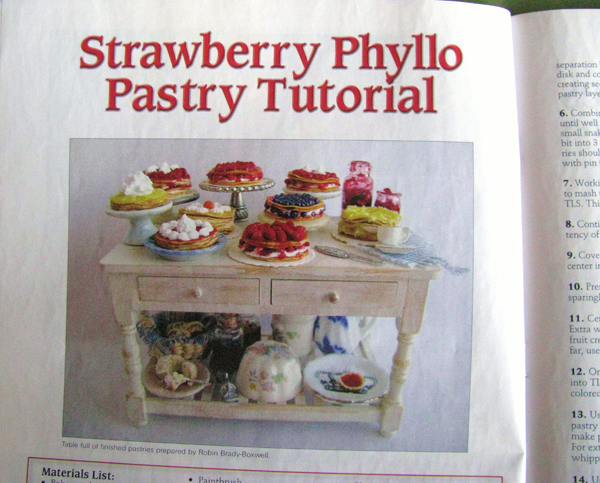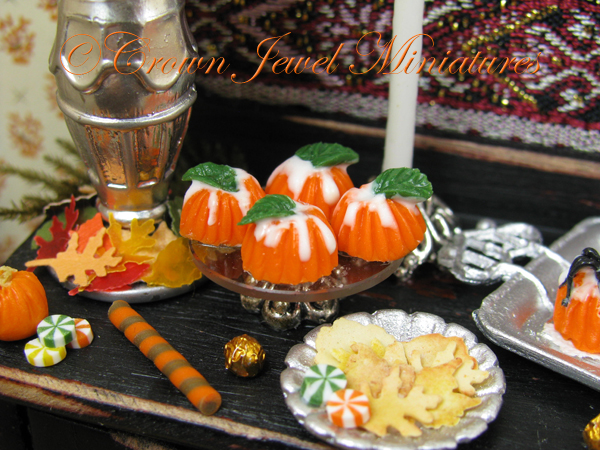How To Finish The Interior Of A dollhouse!
If you’ve read the “Meet The Artisan” page on my website you know that I was the go-to person for dollhouse interior design while I worked at Dollhouses Plus. In addition to selecting and matching decorating components, I installed them and over the years I’ve had several requests for tips. While I no longer finish dollhouses, except my own, I know that even the most amazing dollhouse food won’t look like much in a bare mini kitchen! Here are my recommendations for finishing the interior of your dollhouses. I hope this helps!
FINISHING MATERIALS
Each of the following items can be found at Home Depot, Lowe’s or any hardware or home improvement store:
Plastic scrapers – 1″, 2″ & 4″ wide
Cheap craft paintbrush 1″ wide
Medium grit sanding block
Mini paint roller & tray
White satin or semi-gloss paint (I use Valspar from Lowe’s, sold by the quart)
Scotch transparent tape
Wallpaper adhesive (gel) (I use Roman GH-57 from Lowe’s but any wallpaper and border adhesive will work as long as it’s gel. You can use Modge Podge in a pinch but it does not last). Use regular household wallpaper adhesive, don’t waste your money on overpriced mini pots of “dollhouse” adhesive.
Paper towels
Damp paper towels (squeeze out all excess water)
Utility knife
Straight edge ruler
Pencil
Scissors (for wallpaper only)
Disposable nitrile gloves (to protect your hands from flooring adhesives)
Contact cement
The following items can be found online, eBay, craft stores or your local dollhouse shop:
“Easy Cutter” by Northwest Products (for cutting wood, formica tile and wood molding)
Quick Grip glue
Gloop Adhesive (from Model Builder’s Supply)
Modge Podge
1). Construct the dollhouse and do not install windows or stairs.
2). Sand the bare wood with a medium grit sanding block to ensure all surfaces are smooth and free of glue globs.
3). If you plan to electrify the dollhouse, install tape wiring. Cover all brad and eyelet connections with a piece of Scotch transparent tape. This ensures the paint will not interfere with the connections.

Prime The Walls:
Priming is absolutely necessary! Bare wood leaches the moisture out of wallpaper paste, this is even more prevalent with brittle wood in older dollhouses. Over time the wallpaper as the wallpaper adhesive dries out, the wallpaper begins to lift at the corners and edges or unsightly air pockets form behind the wallpaper. A paint primer prevents all that and will also keep the color of wallpaper true, especially wallpapers with with light backgrounds. Want to change your wallpaper in the future? A paint primer will make future wallpaper removal a breeze!.
-Prevent wallpaper from lifting
-Keep wallpaper colors true
-Protect wiring & walls during future wallpaper removal
-Quick & easy future wallpaper removal
4). Prime (paint) the entire interior of the dollhouse with bright white satin paint found in any home improvement or hardware store. Add additional coats until the wood is no longer visible through the paint. This usually requires 2 or 3 coats, depending on how dry the wood is. Allow to dry thoroughly, usually 3 to 5 days.

FINISH ORDER: Finish every room, top to bottom- start with the ceiling, then walls, flooring and save stairs, molding, wainscoting and trim for last.
CEILINGS: Either leave the ceilings white, as is, or use dollhouse ceiling paper or fancy textured, household wallpaper in white. Use damp paper towels to wipe ceiling free of dust before beginning. Measure the ceiling and roll out the ceiling paper on a clean surface, finished side down. Using a ruler, mark the measurements in pencil and use a craft knife along the side of the ruler to cut. (^If you are unsure of the accuracy of your measurements, leave an extra 1/8″ – 1/4″ margin on the open end of the ceiling to compensate. You can always trim away the excess). Even if the ceiling paper is pre-pasted, use a 1″ wide craft brush and brush on household wallpaper adhesive gel. Press the paper to the ceiling and use the 4″ plastic scraper to smooth the paper onto the ceiling, taking care to smooth away all bubbles and wrinkles. Use dry paper towels to wipe excess wallpaper gel from your scraper after every stroke. Use a firm stroke from the center of the ceiling to the edges to squeeze out the excess wallpaper gel. Use the scraper and damp paper towels to wipe away the excess, then use dry paper towel to ensure the edges are dry and let the ceiling paper dry at least 4 to 6 hours. ^When thoroughly dry, slice away any excess using a sharp craft knife, held flush with the edge of the ceiling.
WALLS:
Smooth Painted Walls:
If you installed wiring, you cannot just paint the walls in pretty decorator colors as the bulk of the tape wire and splices will be visible through the white primer and your paint. You must wallpaper the room with plain, smooth, wallpaper and then paint over the wallpaper. Use damp paper towels to wipe walls and floors free of any dust before beginning.
Textured Painted Walls:
Install textured wallpaper and when thoroughly dry, paint it in a color of your choice… or… if using a textured paint, install plain, smooth wallpaper, let dry and then stipple your textured paint onto the plain wallpaper. Brush textured paint onto the wallpaper using an “X” stroke, sweeping the brush downward on one line of the “X” and upward on the other.
Papered Walls: Measure each wall from floor to ceiling and subtract 1/4″. This is the height you will cut your wallpaper. Lay the full sheet of wallpaper on a clean surface, finished side down. Using a ruler, mark the measurements lightly in pencil and using an X-Acto craft knife along the side of a straight edge ruler, cut the bottom of the wallpaper. Do not use scissors to cut wallpaper! Even the sharpest pair will not give you a straight, even, edge. It is not necessary to leave any margin for error, as the bottom of the wall will be covered with baseboard molding, thus covering any gap. Even if the wallpaper is pre-pasted, use a 1″ wide craft brush to apply wallpaper adhesive gel. Be sure to cover the paper entirely, especially the corners. Starting with the left side of the room, lay the wallpaper against the wall with the top edge lined up against the ceiling. Use plastic scrapers to smooth out any wrinkles and bubbles, sweeping the scraper down the wall, in overlapping strokes. Take extra care to be gentle with cheaper dollhouse wallpapers, which are thin and delicate. Use dry paper towels to wipe excess wallpaper paste gel from your scraper after every stroke. If you get a little on the face of your wallpaper, use a clean, damp paper towel and gently wipe it off. Do not scrub or you may ruin the print of your wallpaper. (Coated or sealed wallpapers are far more durable and less susceptible to damage). Begin the next sheet of wallpaper slightly overlapping the side of the one you just installed by 1/8″. (As wet wallpaper dries, it shrinks, and the overlap will prevent any gap in coverage. You can butt the sides of the wallpaper flush against each other but there is no guarantee the wallpaper will not shrink when dry and you may have gaps). When cutting the final sheet of wallpaper, leave a 1″ extra margin (this will be trimmed away after it dries). Use the scraper, then the damp paper towels to wipe away excess paste. Use a dry paper towel to ensure the edges are clean and dry and let the wallpaper dry at least 4 to 6 hours. After wallpaper is dry, use a sharp craft knife or razor blade and cut an “X” inside the window openings and trim the wallpaper away. Remove excess wallpaper from the edge of the wall with a utility knife held flush with the edge of the wall. Install painted window frames with a thin line of Quick Grip glue on the back side, taking care to wipe away any glue globs, interior and exterior, with damp paper towels immediately after installation. Hold in place 1 minute and let dry.
FLOORS:
Strip Wood Floor Planking: If using wood strips or tongue depressors, I use an “Easy Cutter” by Northwest Products to cut the wood to size. Use a cheap 1″ craft brush to apply Gloop or other non-water based glue. Contact cement works well too but only brush on a little at a time as it will dry out before you can lay the entire floor. Wipe away any excess as you go with damp paper towels.
Wood Floor Sheets & Carpet: Measure the floor and lightly mark the top of your wood flooring. (Use an eraser to remove the marks after installation). It’s important to mark the top of your flooring… or reverse the measurement when you mark the back of the flooring (mirror image) because dollhouse rooms are never perfectly squared. (Your floor may be 1/4″ wider at the back of the room than at the front). Using manufacturers directions, brush recommended adhesive directly onto the dollhouse floor and lay flooring sheet flat on the floor, pressing firmly into place. Using a smooth, plastic scraper, press down firmly with broad strokes in the direction of the wood grain, giving extra attention to the edges and corners. I do not recommend weighting the flooring unless your weights cover every square inch as partial weight in random areas may result in an uneven floor. Immediately wipe away any excess with damp paper towels. ^I do not use contact cement, etc. I use Quick Grip glue, applied via a thin line around the edge of the flooring and a few squiggly lines in the center.
Plastic Tile Sheets
Follow the same procedure with plastic tile sheets, but use a lighter touch when pressing down and do not use a scraper. Wear nitrile gloves to protect your hands as the finish on most plastic sheet flooring tends to come off easily. Press the tile sheets into place with firm hands, wiping away any excess adhesive with damp paper towels. I use Quick Grip glue.
Follow the same procedure with carpet, but use either Modge Podge or tacky glue thinned with water. Brush a thin layer of adhesive directly onto the dollhouse or roombox floor paying careful attention to the edges and corners. Smooth the carpet with a 4″ wide smooth plastic scraper, working from the back of the room to the front and wipe away any excess adhesive with damp paper towels.
MOLDING: Measure the width of each wall and cut the molding to size. Use the Easy Cutters to cut molding to size and for angled joins on inside corners use the Easy Cutters to cut the end of the molding on an angle. Household scissors are not recommended! Even the sharpest pair of scissor will compress and distort the wood and every join will be noticeably uneven! To decrease the chance of glue globs, run a very thin line of Quick Grip glue down back center of the molding. Beginning on the left, outer corner, press the molding into place and hold for a minute or two until set.

STAIRS: Build stairs to fit and stain or paint to match the room. Install stairs, and wipe away excess glue with damp paper towels. I use Quick Grip to install staircases.
REMOVING WALLPAPER & CARPET:
If you followed my instructions and primed your walls before installing wallpaper in your dollhouse, then wallpaper removal is going to be quick & easy and your wiring will not be damaged!
Let’s remove the gold wallpaper from my dining room. Usually vinyl coated wallpaper is difficult to remove, but with primed walls this will be easy…

For Regular Wallpaper: Soak a kitchen sponge in very hot water and hold the sponge against the wallpaper until thoroughly saturated. Let the water soak in for several minutes to loosen the wallpaper, then use the scraper to remove. The wetter the wallpaper, the easier it is to remove. Hot water is more effective than warm water! Protect your wood floors with dry paper towels and blot excess water as you go.
For Vinyl Coated Wallpaper: Tear the vinyl layer away from the paper backing of the wallpaper, then follow the instructions above for removing regular wallpaper.

Notice the paper backing of the wallpaper turns dark when saturated with hot water…

When all visible wallpaper residue has been removed, use a clean sponge soaked in hot water to rub away all vestiges of wallpaper paste until the primed (painted) surface below is smooth. Protect your wood floors with dry paper towels and blot excess water as you go. If necessary, gently use a scraper blade to remove stubborn bits of wallpaper paste (or glue). Sponge down the wall with hot water until all residue is removed. Sandpaper is not recommended; it will pit your walls and destroy your tape wire!
Voila! Easy wallpaper removal. This room is now ready to be repapered…

©Copyright 2015 Crown Jewel Miniatures. All rights reserved.
Robin ♥
IGMA Artisan Robin Brady-Boxwell
DISCLAIMER: The tips included in this blog post are intended as suggestions only and do not constitute professional advice or instructions. Always refer to manufacturers directions and product safety warnings. I am not responsible for any damages you may incur.



















































